当前位置:网站首页>Advance Computer Network Review(1)——FatTree
Advance Computer Network Review(1)——FatTree
2022-07-06 09:02:00 【Zheyuan Zou】
This series is right 21~22 Review outline of advanced computer network course in summer semester of the academic year , This is the first article in this series :FatTree Use in the data center , The main coverage is as follows :
1. Topology and addressing scheme
2. Routing algorithm , Find the routing path between any two hosts
Original paper :《A Scalable, Commodity Data Center Network Architecture》SIGCOMM’08
One 、 Topology and addressing scheme
First of all, this article reviews some problems in data center communication , Then, aiming at these problems, a method based on fat tree (Fat Tree) Of Clos Topology to connect commodity Ethernet switches . The proposed architecture is as follows , It shows a k Yuanpang tree (k=4) The architecture of the figure :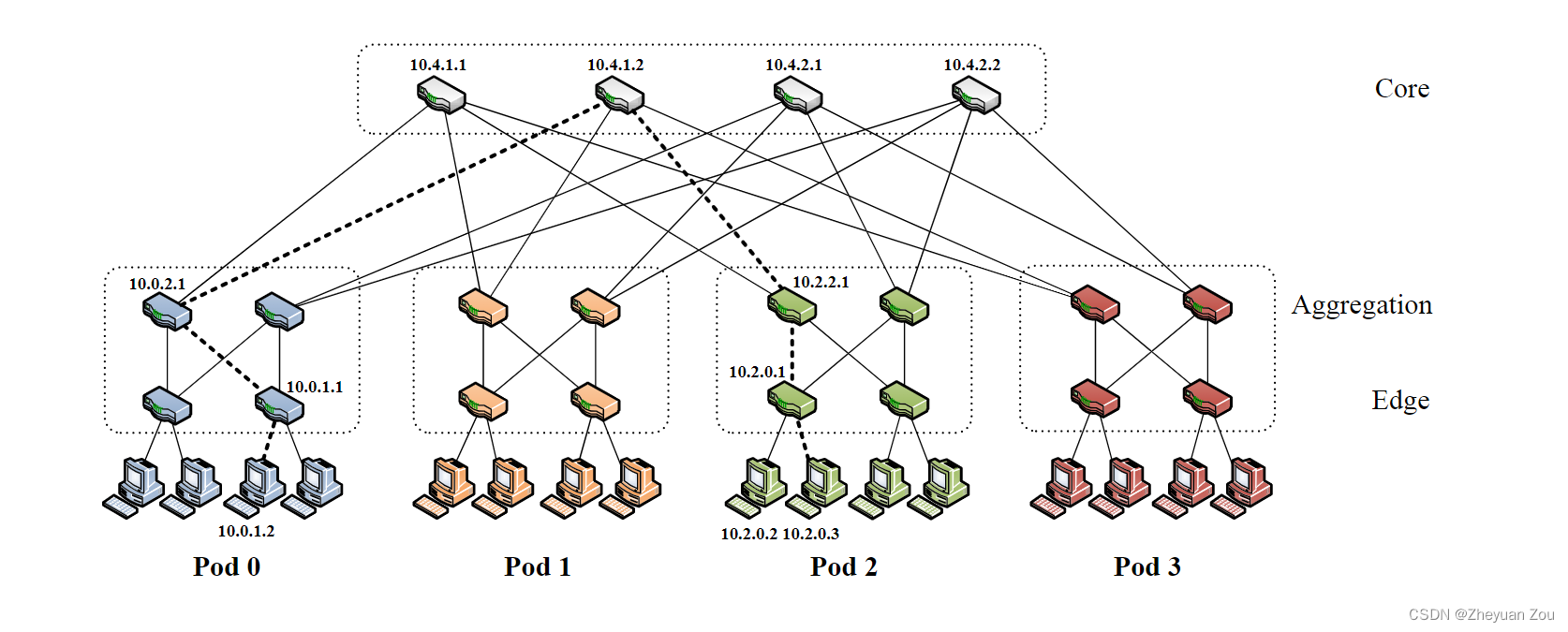
k Yuanpang tree The architecture has the following characteristics :
1. Yes k individual pods, Every pods contain 2 layer , Each layer contains k 2 \frac{k}{2} 2k A switch .
2. every last k Oral exchange , k 2 \frac{k}{2} 2k Ports are directly connected to the host at the bottom (hosts), The rest k 2 \frac{k}{2} 2k Ports are connected up to the high-level switch .
3. Topmost ( k 2 ) 2 {(\frac{k}{2})}^2 (2k)2 Core switches also have k Ports , And The first i Port is just connected to i individual pod, therefore pod Continuous ports in the aggregation layer are represented by k 2 \frac{k}{2} 2k Step by step connection to the core switch (?, This needs to be understood ).
4.k In the yuanpang tree, for different positions pod Host in , Yes ( k 2 ) 2 {(\frac{k}{2})}^2 (2k)2 The shortest path is optional , But only one of them will be chosen .
Now let's take a look at the addressing scheme in this architecture , First of all, the original text clearly states , All in the block IP The addresses are taken from Private address space 10.0.0.0/8 in . The addressing method is located at different levels according to the equipment , It can be divided into the following three situations :
1.pod Switches in , For this kind of switch , The addressing scheme is 10.pod.switch.1,pod That's where it is pod Number ,switch It is in its own pod Number in , This number follows From left to right , Bottom up ( Be careful The priority of left and right is higher than that of up and down ) The addressing order of , The value range is [0,k-1]. For example, in the diagram above pod2, from 4 In a grid of switches , The compilation space is [0,3], On the lower left is 0, On the lower right is 1, On the left is 2, On the right is 3.
2. Core switch , For this kind of switch , The preparation scheme is 10.k.j.i,k Is the element , In the diagram k Namely 4. The original says (j, i) Refers to the switch in ( k 2 ) 2 {(\frac{k}{2})}^2 (2k)2 In the core switch grid coordinate , The scope is [1, k 2 \frac{k}{2} 2k], from Start addressing in the upper left corner . In fact, in the diagram above , We can regard the core switch layer as a 2x2 Square grid to address .
3. host (host), The address scheme of the host is 10.pod.switch.ID,pod,switch Meaning and 1 In the same way , I won't repeat .ID Indicates the location of the host in its subnet , The value range is [2, k 2 + 1 \frac{k}{2} + 1 2k+1], Address from left to right , because 1 Occupied by the switch ,255 Out-of-service . There is also a sentence mentioned in the original text , Each low-level switch is responsible for one containing k 2 \frac{k}{2} 2k A host of /24 subnet (k < 256).
Two 、 Routing algorithm
This part discusses how to complete routing in the above architecture .
1.pod Internal information exchange
First , In a pod Switches in ( Whether low or high ) All keep this pod Prefixes of all subnets under its jurisdiction , This also means that if it is a pod Internal information forwarding . Then this message is being forwarded to pod Of High level switch Will be forwarded to the corresponding subnet .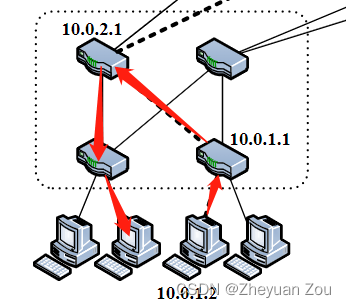
2.pod The exchange of information between
The routing table used in this article is two-level , The first level uses prefix matching , The second level uses suffix matching . Prefix matches are used for pod Internal routing , Suffix matches for pod The route between , The record of the secondary table in the primary table is 0.0.0.0/0.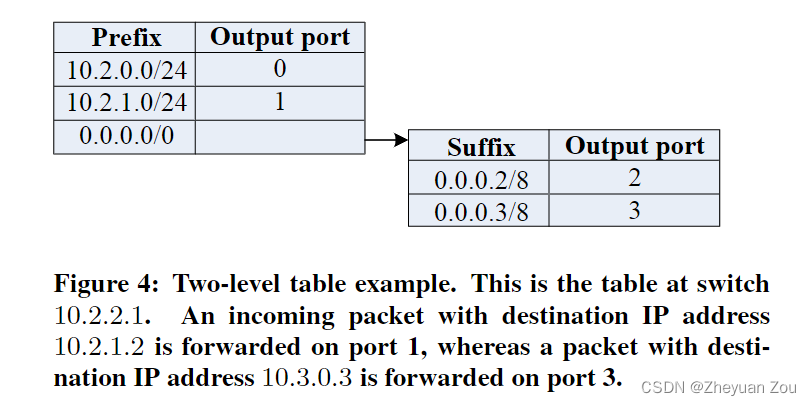
This involves the generation of routing tables for two devices , One is pod The switch inside , Another is the core switch , Their algorithms for generating routing tables are different .
First of all to see pod The switch in , There are also two situations , One is Switch on top , The other is Switch at the bottom .
For being in Top level switch , The routing table generation algorithm is as follows :
among 3-5 Line this code is for pod Internal switching provides routing items , and 6-9 Yes, it is pod The exchange between provides routing items , According to the formula (i-2+z)mod(k/2)+(k/2) The calculated port can span pod The information of accessing the specified host is forwarded from the correct port , The purpose of modular operation is Ensure load balancing .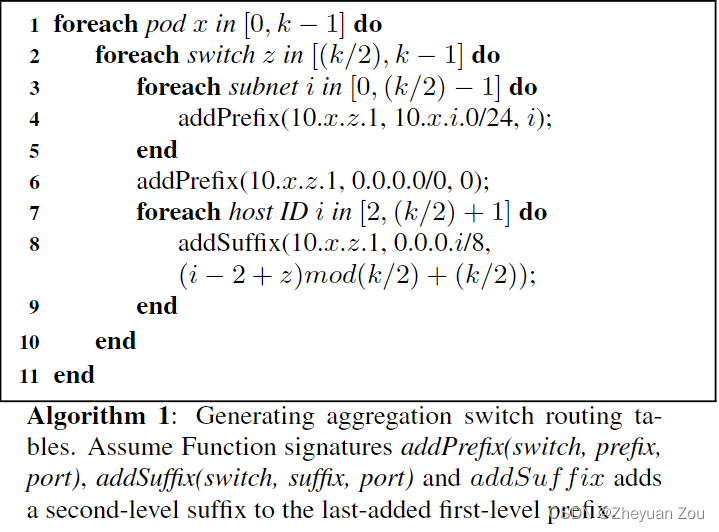
For switches located at the bottom , It does not need to be responsible for forwarding to the subnet , Only responsible for forwarding to the specified host , therefore 3-5 The logic of the line can be erased , Of course The switch number in the second line should also be moved :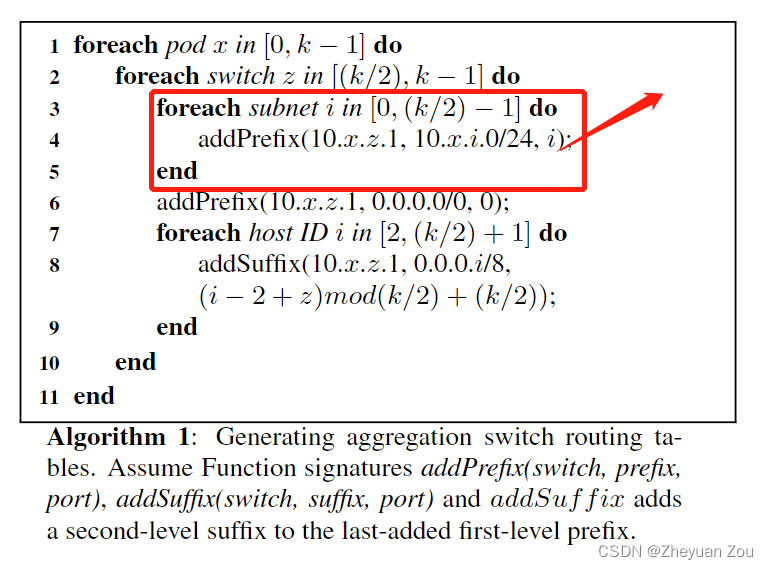
For core layer routing , The routing table generation algorithm is as follows , In fact, it is the designated pod, Forward from the specified port ( As I said before, the core switch is i Port is just connected to i individual pod):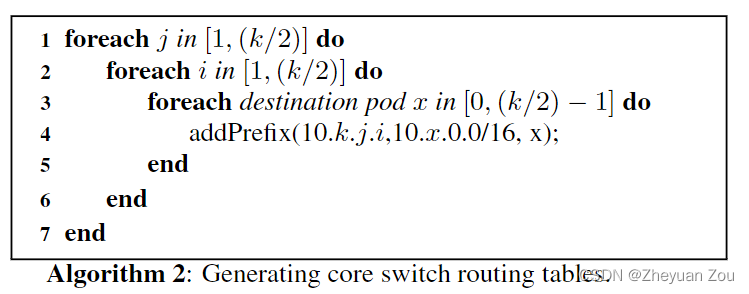
At last, the article gives a cross pod Routing examples :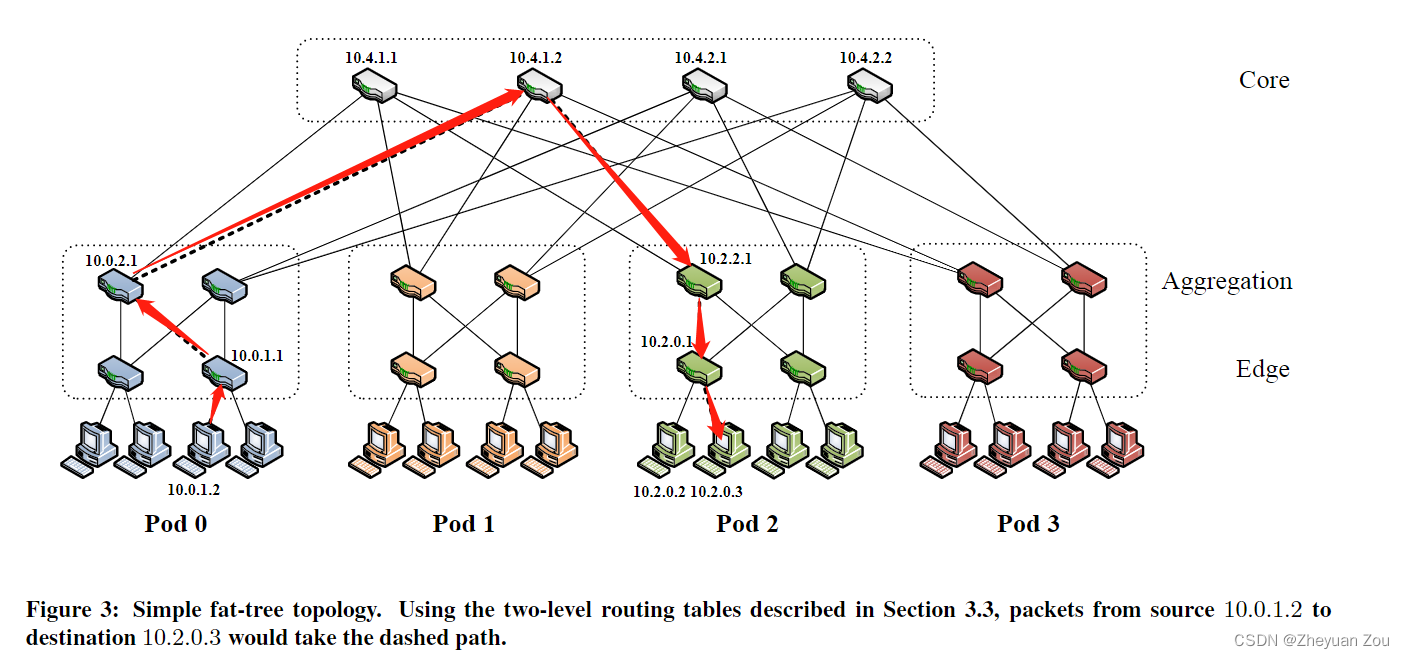
1. from 10.0.1.2 To 10.0.1.1, from Standard switching technology complete , because 10.0.0.1 Is the gateway of the source host .
2.10.0.0.1 To 10.0.2.1, Check the secondary routing table ( The suffix match , Be careful i=3), Send it from the corresponding port .
3.10.0.2.1 To 10.4.1.2, Check the secondary routing table , Forward from the corresponding port .
4. from 10.4.1.2 To 10.2.2.1, You can get the first level routing table 10.2.0.0/16 The matching of , To forward to pod2.
5. from 10.2.2.1 To 10.2.0.1, Because at this time, it is in the same place with the destination network pod in , So at this time, you can get a match from the first level routing table 10.2.0.0/24.
6. from 10.2.0.1 To 10.2.0.3, from Standard switching technology complete .
This is the end of combing and learning this article .
边栏推荐
- LeetCode:41. 缺失的第一个正数
- What is an R-value reference and what is the difference between it and an l-value?
- pytorch查看张量占用内存大小
- CUDA realizes focal_ loss
- Philosophical enlightenment from single point to distributed
- 数字人主播618手语带货,便捷2780万名听障人士
- Warning in install. packages : package ‘RGtk2’ is not available for this version of R
- Intel Distiller工具包-量化实现2
- LeetCode:34. 在排序数组中查找元素的第一个和最后一个位置
- Pytest parameterization some tips you don't know / pytest you don't know
猜你喜欢
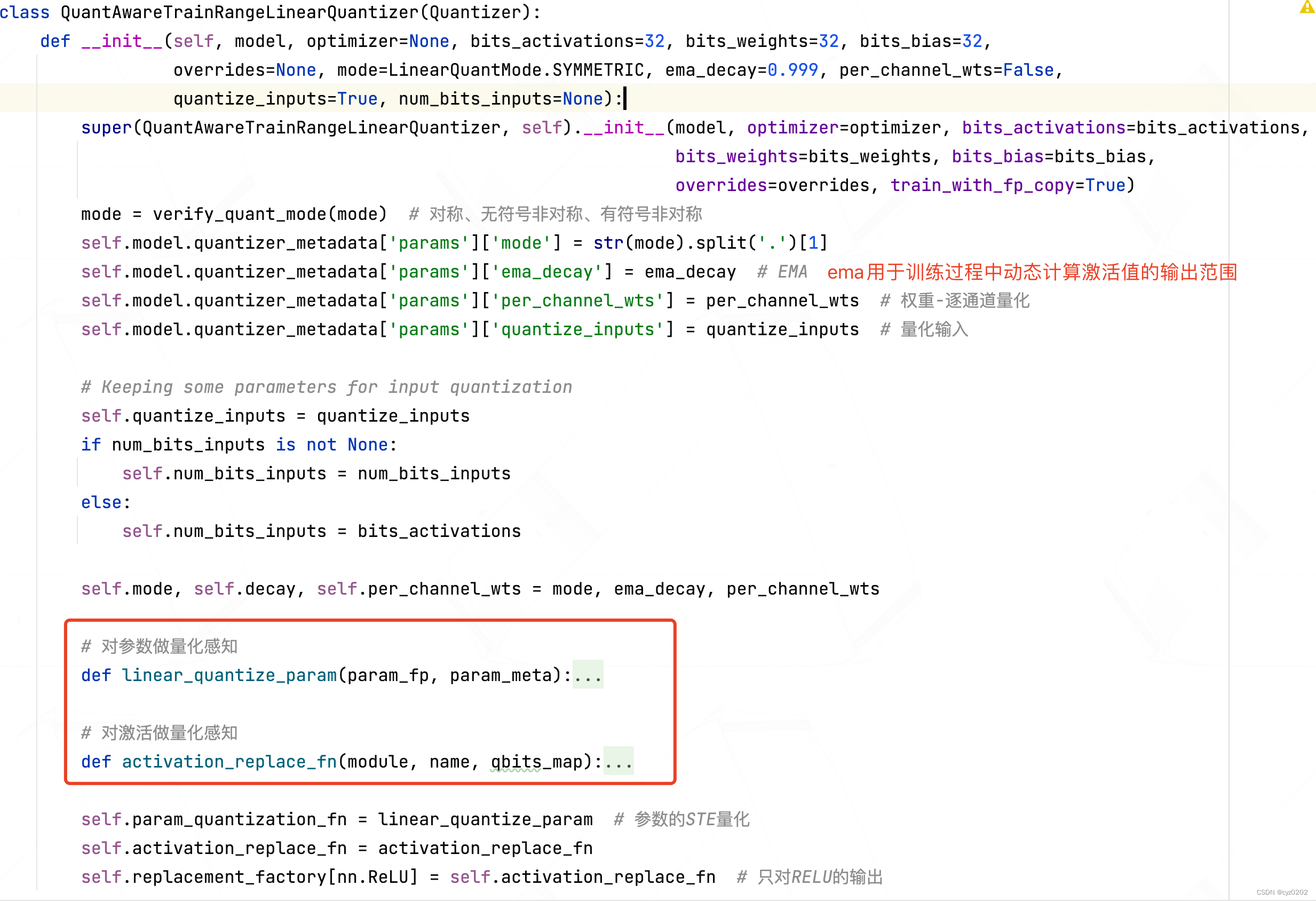
Intel distiller Toolkit - Quantitative implementation 3
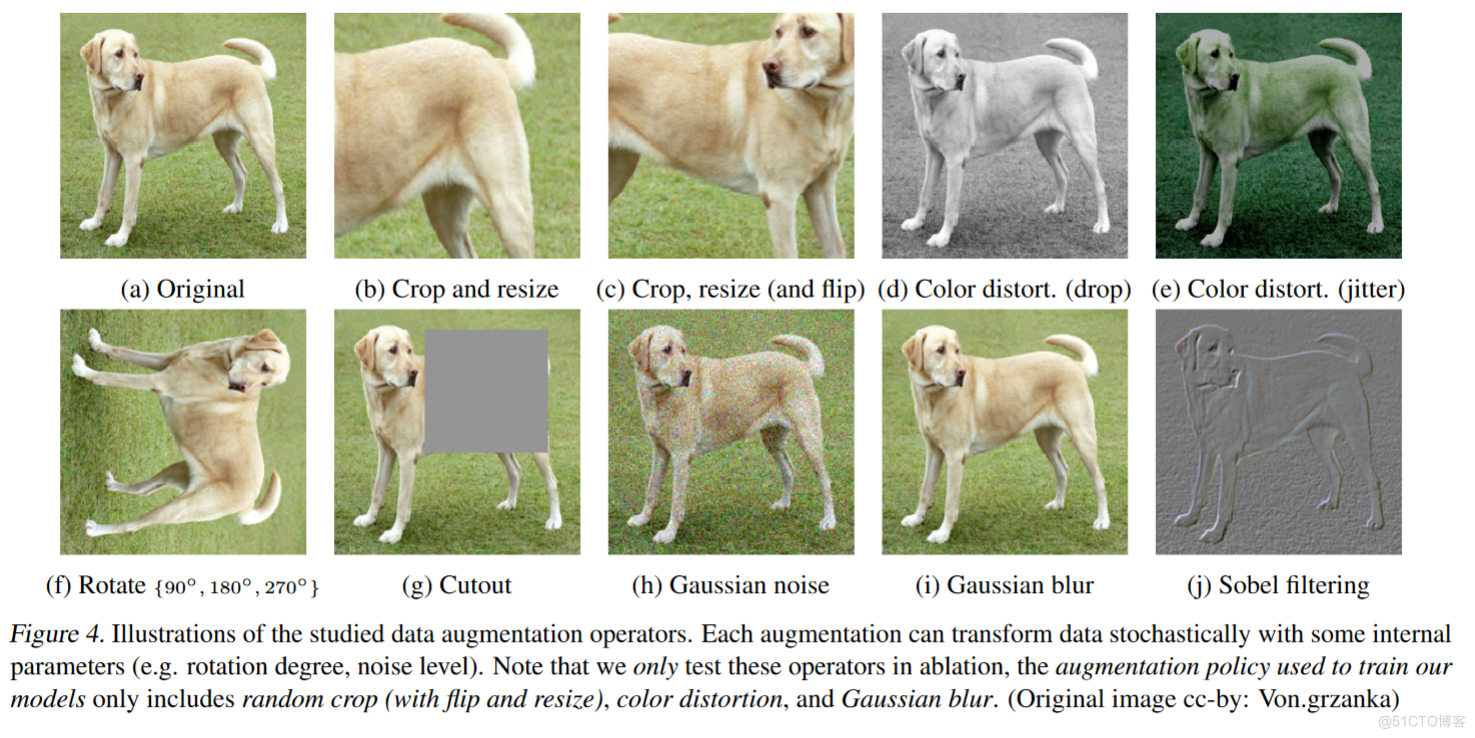
Simclr: comparative learning in NLP
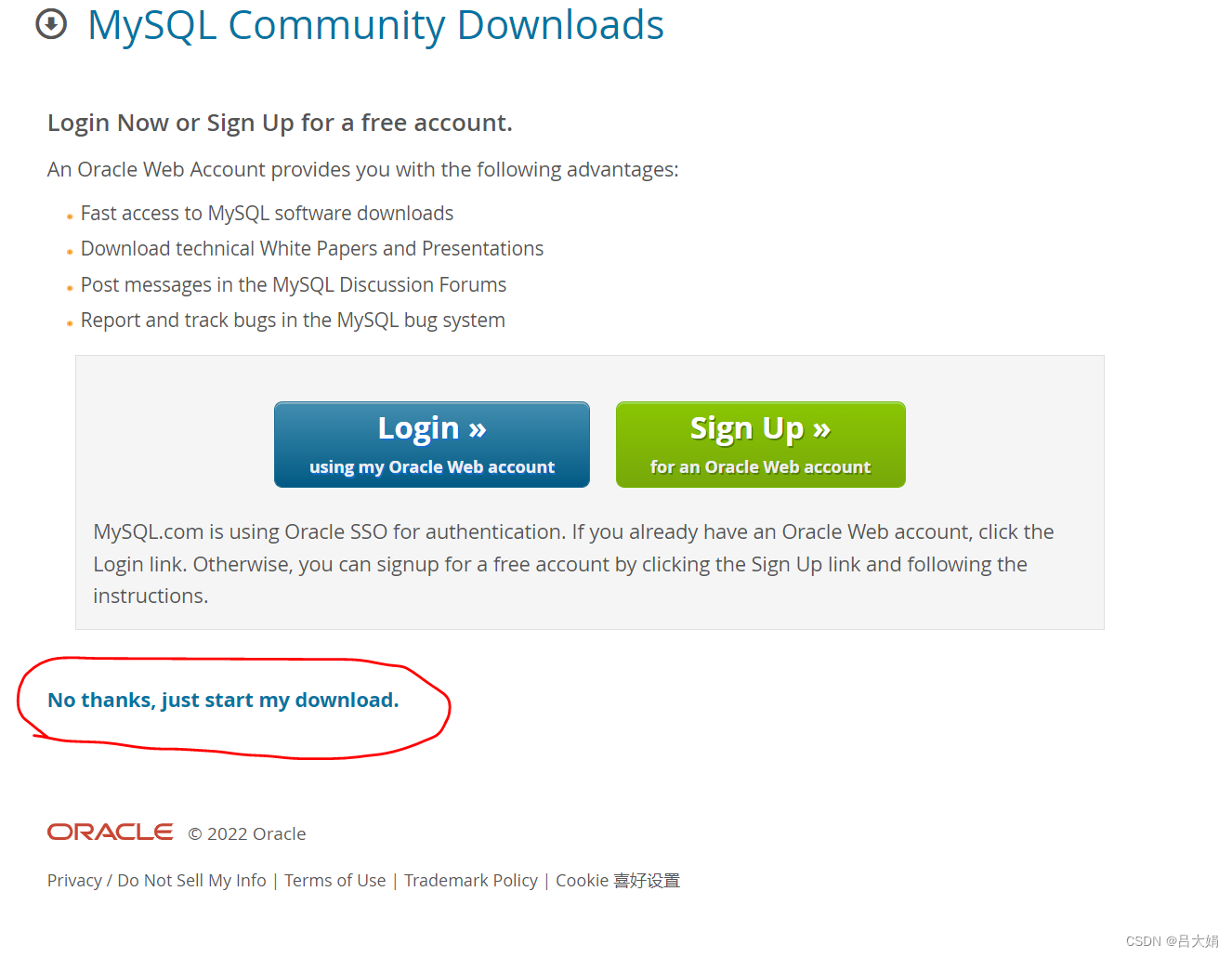
MySQL uninstallation and installation methods
![[OC-Foundation框架]--<Copy对象复制>](/img/62/c04eb2736c2184d8826271781ac7e3.png)
[OC-Foundation框架]--<Copy对象复制>

MongoDB 的安装和基本操作

Alibaba cloud server mining virus solution (practiced)

In depth analysis and encapsulation call of requests
![[today in history] February 13: the father of transistors was born The 20th anniversary of net; Agile software development manifesto was born](/img/70/d275009134fcbf9ae984c0f278659e.jpg)
[today in history] February 13: the father of transistors was born The 20th anniversary of net; Agile software development manifesto was born
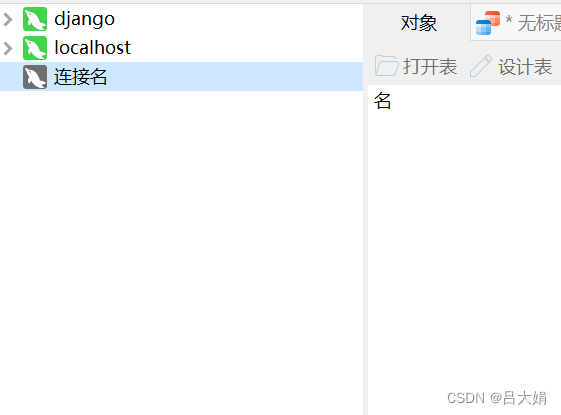
Problems encountered in connecting the database of the project and their solutions
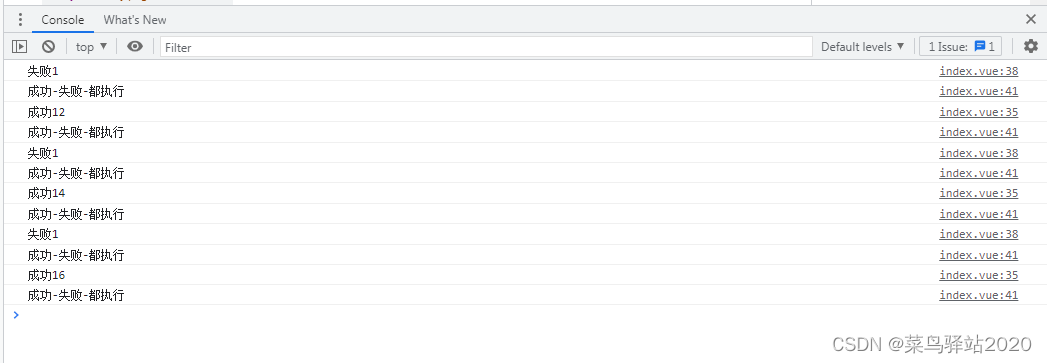
Simple use of promise in uniapp
随机推荐
CSP first week of question brushing
Compétences en mémoire des graphiques UML
LeetCode:498. Diagonal traversal
Selenium+pytest automated test framework practice
LeetCode:34. 在排序数组中查找元素的第一个和最后一个位置
R language uses the principal function of psych package to perform principal component analysis on the specified data set. PCA performs data dimensionality reduction (input as correlation matrix), cus
LeetCode:41. Missing first positive number
How to effectively conduct automated testing?
【嵌入式】使用JLINK RTT打印log
TP-LINK enterprise router PPTP configuration
CUDA realizes focal_ loss
What are the common processes of software stress testing? Professional software test reports issued by companies to share
[text generation] recommended in the collection of papers - Stanford researchers introduce time control methods to make long text generation more smooth
SAP ui5 date type sap ui. model. type. Analysis of the parsing format of date
[today in history] February 13: the father of transistors was born The 20th anniversary of net; Agile software development manifesto was born
Tdengine biweekly selection of community issues | phase III
Computer graduation design PHP Zhiduo online learning platform
I-BERT
LeetCode:剑指 Offer 03. 数组中重复的数字
一改测试步骤代码就全写 为什么不试试用 Yaml实现数据驱动?